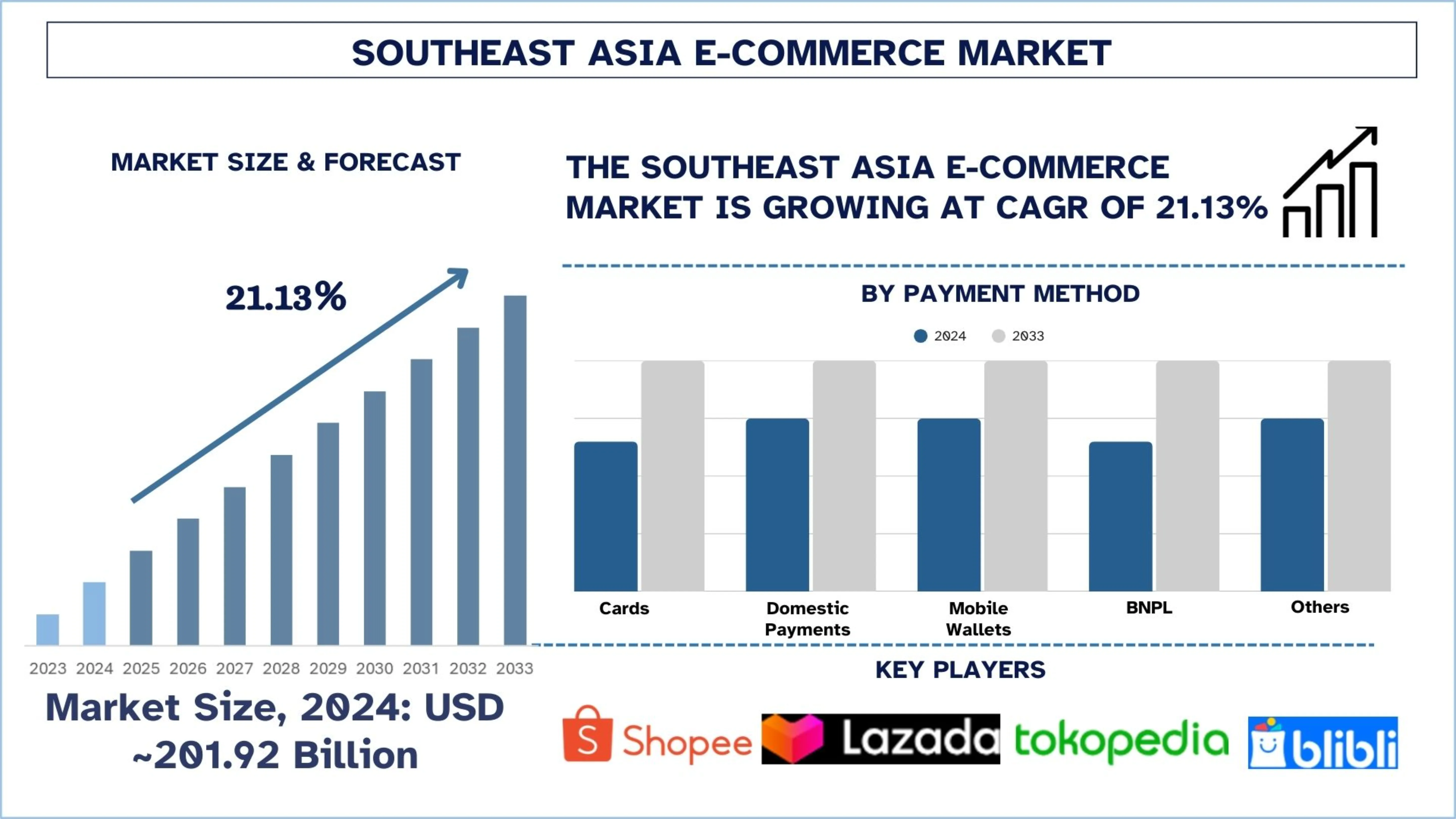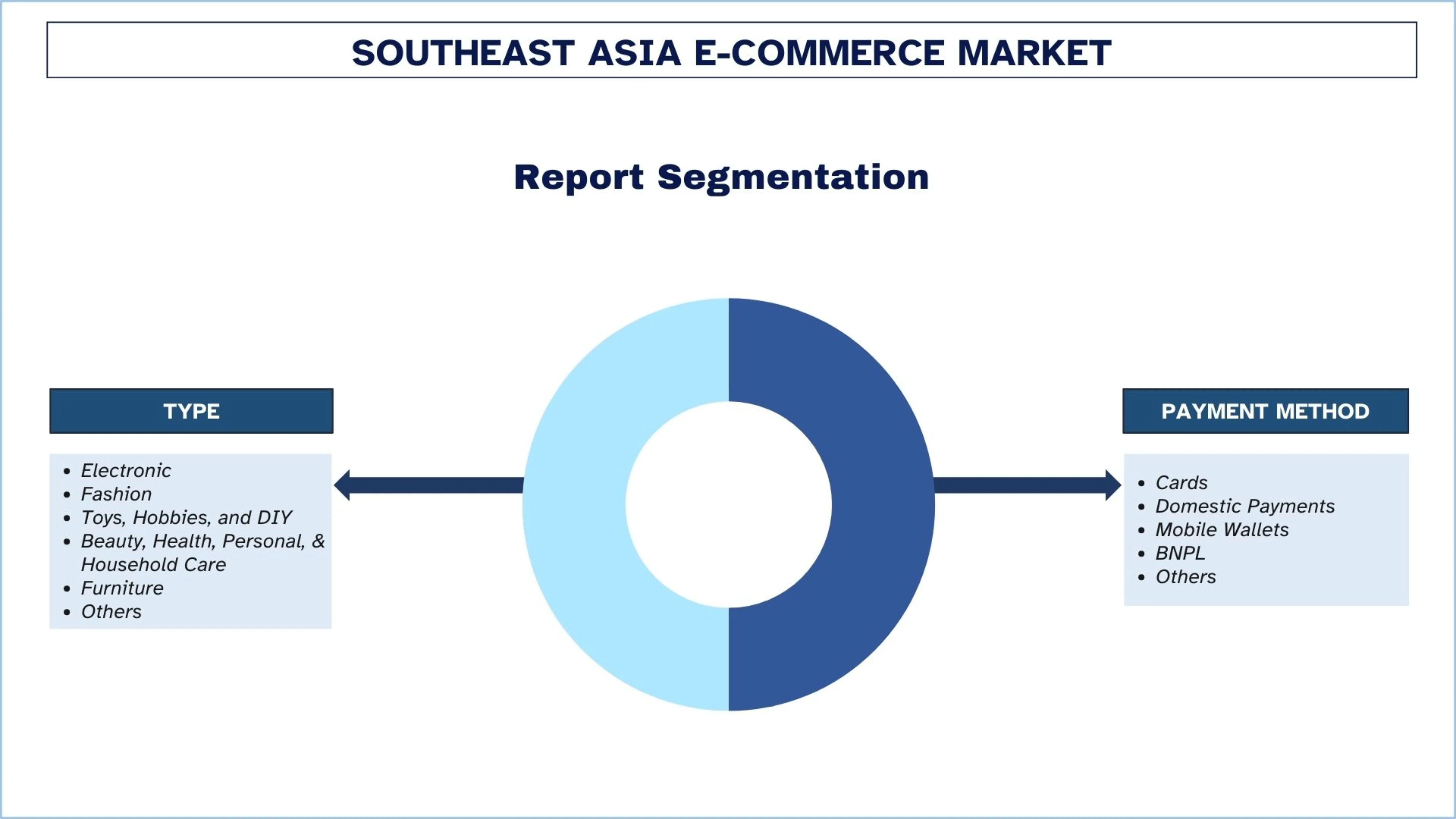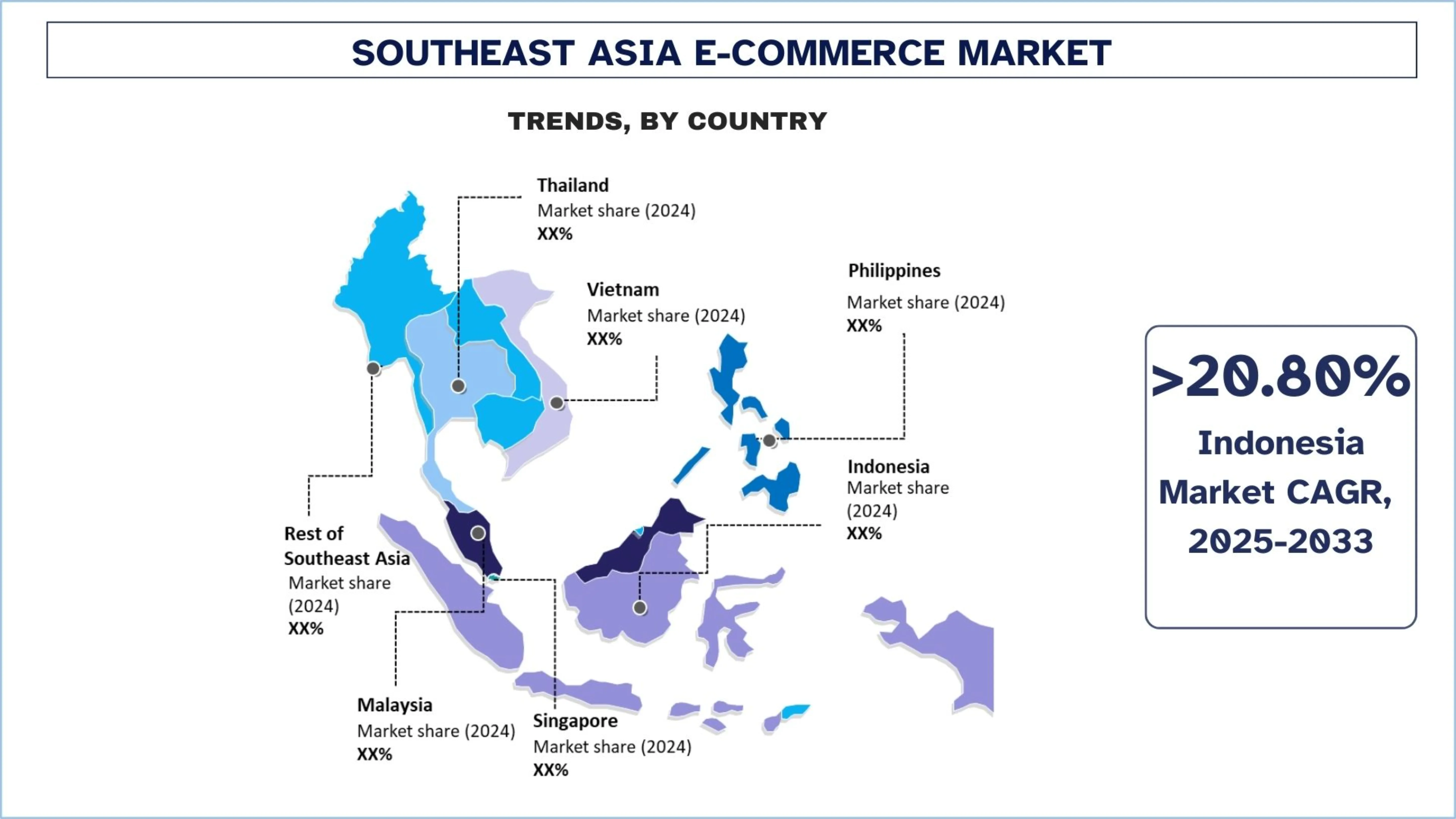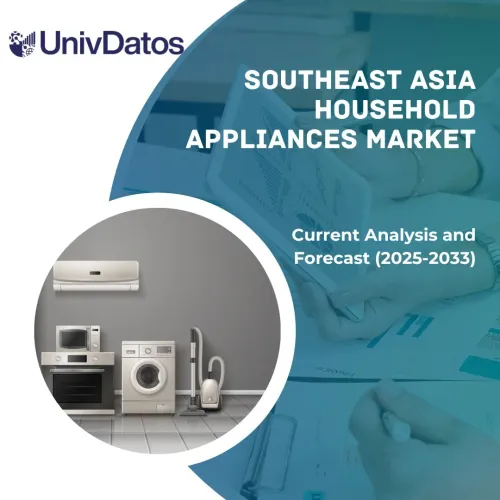- Home
- About Us
- Industry
- Services
- Reading
- Contact Us
Southeast Asia E-Commerce Market: Current Analysis and Forecast (2025-2033)
Emphasis on Type (Electronic; Fashion; Toys, Hobbies, and DIY; Beauty, Health, Personal, & Household Care; Furniture; Others); Payment Method (Cards, Domestic Payments, Mobile Wallets, BNPL, Others); and Country.

Southeast Asia E-Commerce Market Size & Forecast
The Southeast Asia E-Commerce market was valued at USD 201.92 billion in 2024 and is expected to grow at a strong CAGR of around 21.13% during the forecast period (2025-2033F). This rapid expansion is fueled by rising internet penetration, a growing middle-class population, and the increasing adoption of mobile shopping and digital payments across the region.
Southeast Asia E-Commerce Market Analysis
E-commerce refers to the commercial transactions that include commissioning commercial dealings via the internet, in which companies advertise products or services through websites or mobile apps, utilizing digital payment systems and delivery networks. Also, it enables cross-border commerce, personalized shopping, and the utilization of data-driven insights to enhance customer experience and efficiency.
The strategies that companies in Southeast Asia are adopting toward e-commerce growth include the use of mobile wallets to facilitate easy payments. Also, expanding BNPL programs to reach younger consumers and creating AI-driven recommendation engines to enhance personalization. Adding to this, the rising investments in logistics and last-mile delivery, and collaboration with local sellers are being pursued to enhance product variety and affordability.
On July 2, 2025, DHL announced a strategic partnership with Saha Group, a subsidiary of Saha Pathanapibul Public Company Limited, Thailand's leading consumer goods organization, to enhance Saha Group's capabilities in both domestic and global e-commerce markets. This collaboration aligns with one of DHL Group Strategy 2030 's growth initiatives, geographic tailwinds, which aims to help Thai companies extend their reach and boost expansion with DHL’s global network and local expertise.
Southeast Asia E-Commerce Market Trends
This section discusses the key market trends that are influencing the various segments of the Southeast Asia E-Commerce market, as found by our team of research experts.
Integration of AR/VR and Immersive Shopping
The demand for Augmented Reality (AR) and Virtual Reality (VR) technology is transforming the consumer interaction within e-commerce platforms in Southeast Asia. The customer can now virtually try on clothing, sample cosmetics, or preview furniture within their own homes before making a purchase, eliminating apprehension and returns. Furthermore, the virtual experience enhances consumer trust in e-commerce, thereby narrowing the gap between traditional and online shopping. Moreover, large platforms and brands are investing in AR-based experiences to distinguish their products and appeal to younger, more tech-sophisticated buyers. As this trend continues to grow, it is transforming customer expectations and setting new standards for digital shopping experiences.
For example, on March 10, 2022, Southeast Asia's e-commerce platform, Lazada, rolled out realistic AI and AR-powered Virtual Try-On to shoppers, enabling beauty lovers around the region to instantly sample products with pictures or live videos of themselves before making a purchase.
Southeast Asia E-Commerce Industry Segmentation
This section provides an analysis of the key trends in each segment of the Southeast Asia E-Commerce market, along with forecasts at the country level for 2025-2033.
The electronic segment dominated the market share in 2024.
Based on type, the market is segmented into electronic; fashion; toys, hobbies, and DIY; beauty, health, personal, & household care; furniture; others. Among these, the electronic category held the dominant share of the e-commerce market in 2024. The growing digital adoption is creating a boom in demand for smartphones, laptops, and other smart devices. Also, competitive prices, warranties, and flash sales are conducted online, attracting millions of tech-savvy customers. The electronics market is also driven by the fast development of the online-exclusive stores and brand-owned markets in Southeast Asia. For example, on August 14, 2024, Samsung Electronics Philippines Co. announced the release of the new Samsung Shop App in selected markets within Southeast Asia and Oceania, as part of its mission to enhance and streamline the online shopping experience for Samsung users and fans. Purchases of electronic products continue to be made online in large numbers in the Southeast Asia and Oceania region.
The domestic payments market is expected to grow with a significant CAGR during the forecast period (2025-2033).
Based on payment method, the Southeast Asian E-Commerce market is segmented into cards, domestic payments, mobile wallets, BNPL, and others. Among these, the domestic payments market is expected to grow with a significant CAGR during the forecast period (2025-2033) through secure, local, and convenient transactions that are customized to meet the financial ecosystem of countries. It helps consumers with the inaccessibility of international cards, thereby extending the market for e-commerce systems. Additionally, the increasing adoption of this method in emerging Southeast Asian markets is expected through the introduction of bank transfers, local gateways, and cash-linked digital options. For example, on August 19, 2025, NTT DATA Payment Services officially launched ADAPTIS, its unified suite of integrated payment solutions, at a high-profile event in Manila. This is launched in the Philippines after successful rollouts in Malaysia and Thailand, offering five integrated services: In-Store, e-Commerce, Financing, Enterprise, and Value-Added Services.

Indonesia held a dominant share of the Southeast Asian E-Commerce market in 2024
Indonesia has the highest e-commerce market share in Southeast Asia, largely due to its large population, young demographics, and increasing internet penetration. The rise in smartphone adoption and affordable data connectivity is driving online purchases, and sites such as Tokopedia, Shopee, and Bukalapak are capturing a significant share of the consumer market. The barriers to adoption are falling as government efforts to enhance digital payment and logistics infrastructure, along with increased disposable income, are expanding the customer base. Moreover, there is a growing trend of social commerce and live-streaming sales, which improve interaction and sales. Indonesia is witnessing a hub of growth in regional e-commerce players due to its size and constant urbanization. On January 6, 2025, YouTube partnered with Shopee to launch YouTube Shopping in Indonesia, Thailand, and Vietnam. YouTube introduced this seamless shopping experience in September, when it unveiled a partnership with Shopee, the regional e-commerce giant, first in Indonesia, then in Thailand and Vietnam. Users can purchase products featured on YouTube through links to Shopee embedded in the videos.

Southeast Asia E-Commerce Industry Competitive Landscape
The Southeast Asia E-Commerce market is competitive, with several global and international market players. The key players are adopting different growth strategies to enhance their market presence, such as partnerships, agreements, collaborations, new product launches, geographical expansions, and mergers and acquisitions.
Top Southeast Asia E-Commerce Companies
Some of the major players in the market are Shopee (Sea Limited), Lazada (Alibaba Group Holding Limited), PT GoTo Gojek Tokopedia Tbk (GoTo), Blibli (PT Global Digital Niaga Tbk.), Carousell, TI KI Company Limited, PT Bukalapak, ZALORA, Sendo Farm (FPT Corporation), and Qoo10 Singapore.
Recent Developments in the Southeast Asia E-Commerce Market
On August 19, 2025, NTT DATA Payment Services officially launched ADAPTIS, its unified suite of integrated payment solutions, at a high-profile event in Manila. This is launched in the Philippines after successful rollouts in Malaysia and Thailand, offering five integrated services: In-Store, e-Commerce, Financing, Enterprise, and Value-Added Services
On June 22, 2025, Vietnam’s Ministry of Industry and Trade (“MOIT”) released the first draft of the Law on E-Commerce (“Draft Law”) for public consultation. This marks a major development in the country’s digital regulatory landscape. Until now, Vietnam’s e-commerce sector has been governed primarily by sub-law instruments, most notably Decree No. 52/2013/ND-CP dated 16 May 2013, as amended (“Decree 52”).
Southeast Asia E-Commerce Market Report Coverage
Details | |
Base year | 2024 |
Forecast period | 2025-2033 |
Growth momentum | Accelerate at a CAGR of 21.13% |
Market size 2024 | USD 201.92 Billion |
Country analysis | Indonesia, Thailand, Philippines, Vietnam, Malaysia, Singapore, Rest of Southeast Asia |
Major contributing Country | Vietnam is expected to grow at the highest CAGR during the forecasted period. |
Companies profiled | Shopee (Sea Limited), Lazada (Alibaba Group Holding Limited), PT GoTo Gojek Tokopedia Tbk (GoTo), Blibli (PT Global Digital Niaga Tbk.), Carousell, TI KI Company Limited, PT Bukalapak, ZALORA, Sendo Farm (FPT Corporation), Qoo10 Singapore |
Report Scope | Market Trends, Drivers, and Restraints; Revenue Estimation and Forecast; Segmentation Analysis; Demand and Supply Side Analysis; Competitive Landscape; Company Profiling |
Segments Covered | By Type, By Payment method, By Country |
Reasons to Buy the Southeast Asia E-Commerce Market Report:
The study includes market sizing and forecasting analysis confirmed by authenticated key industry experts.
The report briefly reviews overall industry performance at a glance.
The report covers an in-depth analysis of prominent industry peers, primarily focusing on key business financials, product portfolios, expansion strategies, and recent developments.
Detailed examination of drivers, restraints, key trends, and opportunities prevailing in the industry.
The study comprehensively covers the market across different segments.
Customization Options:
The Southeast Asia E-Commerce market can further be customized as per requirements or any other market segment. Besides this, UnivDatos understands that you may have your own business needs; hence, feel free to contact us to get a report that completely suits your requirements.
Table of Content
Research Methodology for the Southeast Asia E-Commerce Market Analysis (2023-2033)
We analyzed the historical market, estimated the current market, and forecasted the future market of the Southeast Asian E-Commerce market to assess its application in major countries. We conducted exhaustive secondary research to gather historical market data and estimate the current market size. To validate these insights, we carefully reviewed numerous findings and assumptions. Additionally, we conducted in-depth primary interviews with industry experts across the Southeast Asian E-Commerce value chain. After validating market figures through these interviews, we used both top-down and bottom-up approaches to forecast the overall market size. We then employed market breakdown and data triangulation methods to estimate and analyze the market size of industry segments and sub-segments.
Market Engineering
We employed the data triangulation technique to finalize the overall market estimation and derive precise statistical numbers for each segment and sub-segment of the Southeast Asia E-Commerce market. We split the data into several segments and sub-segments by analyzing various parameters and trends, including type, payment method, and country within the Southeast Asian E-Commerce market.
The Main Objective of the Southeast Asia E-Commerce Market Study
The study identifies current and future trends in the Southeast Asia E-Commerce market, providing strategic insights for investors. It highlights market attractiveness, enabling industry participants to tap into untapped markets and gain a first-mover advantage. Other quantitative goals of the studies include:
Market Size Analysis: Assess the current and forecast market size of the Southeast Asia E-Commerce market and its segments in terms of value (USD).
Southeast Asia E-Commerce Market Segmentation: Segments in the study include areas of type, payment method, and country.
Regulatory Framework & Value Chain Analysis: Examine the regulatory framework, value chain, customer behavior, and competitive landscape of the Southeast Asia E-Commerce industry.
Country Analysis: Conduct a detailed country analysis for key areas such as Indonesia, Thailand, the Philippines, Vietnam, Malaysia, Singapore, and the Rest of Southeast Asia.
Company Profiles & Growth Strategies: Company profiles of the Southeast Asia E-Commerce market and the growth strategies adopted by the market players to sustain in the fast-growing market.
Frequently Asked Questions FAQs
Q1: What is the Southeast Asia E-Commerce market’s current market size and growth potential?
The Southeast Asia E-Commerce market was valued at USD 201.92 billion in 2024 and is projected to expand at a CAGR of 21.13% from 2025 to 2033. This rapid expansion is fueled by rising internet penetration, a growing middle-class population, and the increasing adoption of mobile shopping and digital payments across the region.
Q2: Which segment has the largest share of the Southeast Asia E-Commerce market by type?
The electronics segment currently dominates the Southeast Asia E-Commerce market, driven by high demand for smartphones, laptops, and consumer gadgets. Affordable pricing, online-exclusive discounts, and brand partnerships with leading platforms such as Shopee, Lazada, and Tokopedia further strengthen this segment’s growth.
Q3: What are the driving factors for the growth of the Southeast Asia E-Commerce market?
Key growth drivers include rising internet and smartphone penetration, digital payment adoption, government support for digitalization, and improved logistics infrastructure. In addition, the rise of social commerce and AI-driven personalization is enhancing user engagement and boosting transaction volumes across the region.
Q4: What are the emerging technologies and trends in the Southeast Asia E-Commerce market?
Emerging trends include the integration of AR/VR for immersive shopping, rapid expansion of social commerce through TikTok Shop and Instagram, and AI-driven chatbots and personalization. Cross-border e-commerce, blockchain for supply chain transparency, and innovations in same-day delivery are also reshaping the competitive landscape.
Q5: What are the key challenges in the Southeast Asia E-Commerce market?
Despite strong growth, the market faces challenges such as logistics bottlenecks in remote areas, cybersecurity risks, regulatory complexities, and intense competition among regional players. Consumer trust and payment fraud prevention remain critical hurdles for platforms aiming to scale sustainably.
Q6: Which country dominates the Southeast Asia E-Commerce market?
Indonesia dominates the Southeast Asia E-Commerce market, accounting for the largest market share due to its large population base, high mobile penetration, and the presence of major platforms such as Tokopedia, Bukalapak, Shopee, and Blibli. Its size and scale make it the most lucrative market for investors and businesses.
Q7: Who are the key players in the Southeast Asia E-Commerce market?
Leading companies in the Southeast Asia E-Commerce market include:
• Shopee (Sea Limited)
• Lazada (Alibaba Group Holding Limited)
• PT GoTo Gojek Tokopedia Tbk (GoTo)
• Blibli (PT Global Digital Niaga Tbk.)
• Carousell
• TI KI Company Limited
• PT Bukalapak
• ZALORA
• Sendo Farm (FPT Corporation)
• Qoo10 Singapore
Q8: What investment opportunities exist in the Southeast Asia E-Commerce market?
Investment opportunities are strong in last-mile logistics, fintech solutions for digital payments, AI-driven retail technologies, and cross-border trade enablement. Businesses and investors are also focusing on niche verticals like fashion, beauty, and groceries, which are showing rapid adoption rates.
Q9: How is the regulatory environment impacting the Southeast Asia E-Commerce industry?
Ans: Regulations across Southeast Asia vary, but most governments are actively promoting digital transformation, consumer protection, and data privacy. Countries like Singapore and Indonesia are implementing clear e-commerce frameworks, which provide confidence to investors, while others are improving tax, customs, and logistics policies to support growth.
Related Reports
Customers who bought this item also bought










